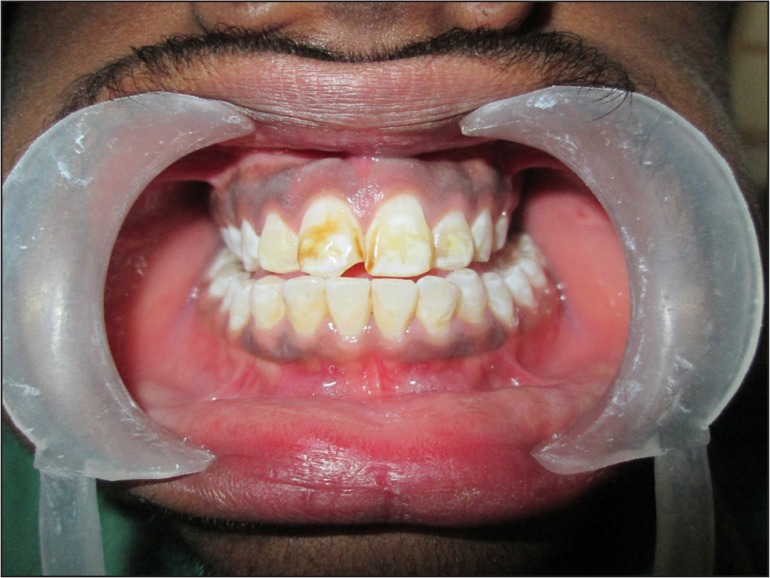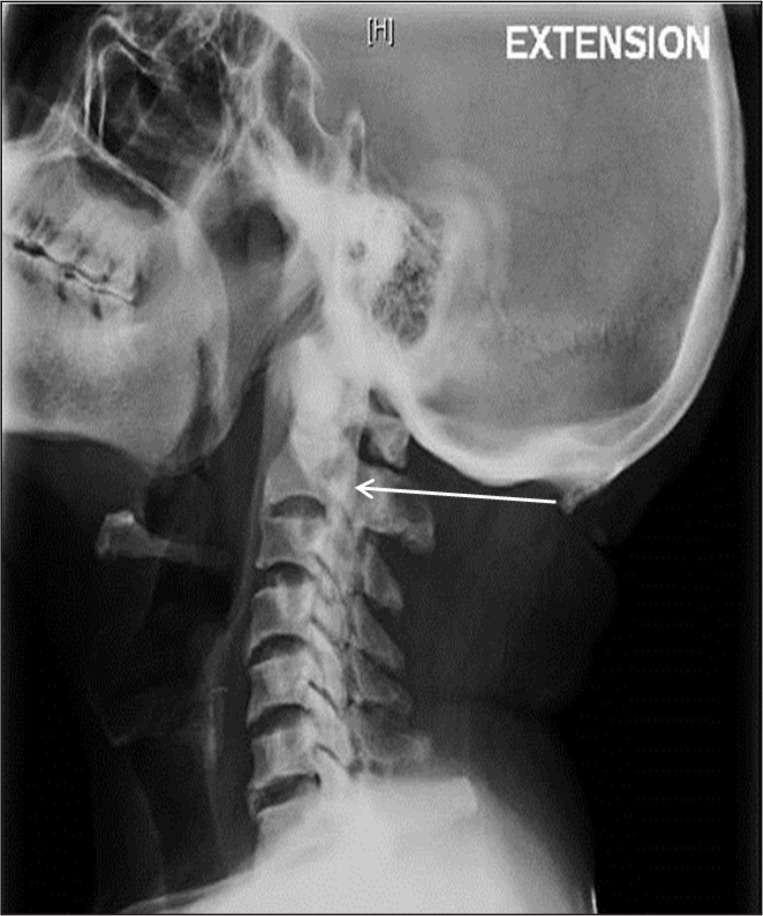CASE REPORT
A 45-year-old man presented to the Department of Medicine at our institution with 1 year of noninflammatory pain in multiple joints. The pain had begun in both knee joints, followed by low-back ache and neck, wrist, and foot pain. There was no associated fever or swelling of any joint. The patient did not report any history of addiction or illness but did report using fluoridated toothpaste. The patient also lived in a region of India where the problem of fluorosis is endemic. On examination, we found his teeth had brown strains and rough, pitted enamel (Figure 1). There was diffuse tenderness at the cervical spine, the lumbosacral spine, and elbow, wrist, knee, and ankle joints. There was no swelling or restriction of movement in any of these areas. There were no neurologic deficits, and the rest of the physical examination was normal. X-ray scans showed osteosclerosis of the knee (Figure 2), ankle, wrist, pelvis, and vertebral column, and calcification of the sacrotuberous ligament (Figure 3) and the posterior longitudinal ligament (Figure 4). Twenty-four-hour urinary fluoride levels were elevated (18 ppm). The patient was advised to avoid fluoridated water, fluoridated toothpaste, and foods containing fluoride. He was kept under close follow-up and was educated about the potential development of neurologic symptoms and signs.
Figure 1.
Teeth showing brown stains and rough, pitted enamel.
Figure 2.
X-ray of the right knee. The white arrow indicates osteosclerosis.
Figure 3.
X-ray of the pelvis. The short arrow shows osteosclerosis of the pelvis and vertebral column. The long arrow demonstrates calcification of the sacrotuberous ligament.
Figure 4.
X-ray of the cervical spine. The white arrow shows osteosclerosis of the posterior longitudinal ligament.
DISCUSSION
Skeletal fluorosis (SF) is endemic in India. India lies in the geographic fluoride belt that extends from Turkey to China and Japan through Iraq, Iran, and Afghanistan.1 In India, 60 million people are estimated to have health problems because of consumption of fluoride-contaminated water.2 In the US, data from a 1999–2004 national health and nutrition examination survey3 and from a 1986–1987 national oral health survey3 of school children showed that about 23% of the population aged 6–49 years had some form of SF. Prevalence of dental fluorosis was higher in adolescents than adults. SF is caused by prolonged ingestion or (rarely) inhalation of fluoride ions.4 Chronic fluoride toxicity leads to poor bone quality and painful calcification and ossification of tendons and ligaments. The generally accepted average serum fluoride level is 0.15 ppm. The World Health Organization has set the upper limit of fluoride concentration in drinking water at 1.5 mg/L.5 The Bureau of Indian Standards has decreed that 1.0 mg/L is the maximum permissible limit of fluoride in drinking water in India.6
Dental fluorosis, also known as mottling of teeth enamel, is divided into three grades7:
Grade 1: White, chalky opacities or patches on tooth enamel with or without faint yellow lines.
Grade 2: Distinct brownish discoloration of the tooth.
Grade 3: Pigmentation and pitting of tooth enamel surfaces, sometimes with chipping of edges.
Changes in fluorosis are most marked in the spine, pelvis, and ribs. Radiologic features of SF include increased bone density (osteosclerosis); osteopenia/osteoporosis; trabecular blurring or haziness; ossification of the attachments of tendons, ligaments, and muscles; interosseous membrane calcification8; and ossification of the posterior longitudinal ligament.9 Urinary fluoride levels are the best indicators of fluoride intake. Since fluoride concentration is not the same throughout the day, 24-hour samples of urine are more reliable. Normal urinary fluoride levels range from 0.1 ppm to 2 ppm. Endemic fluorosis can manifest with both dental and skeletal changes. Management of fluorosis generally focuses on symptom treatment. Patients with SF are advised to keep away from fluoride intake. Fluoride mobilized from the skeleton gets excreted very slowly through urine and feces,10 and patients with SF will excrete large amounts of flouride for years.
Footnotes
Disclosure Statement
The author(s) have no conflicts of interest to disclose.
References
- 1.Saravanan S, Kalyani C, Vijayarani M, et al. Prevalence of dental fluorosis among primary school children in rural areas of Chidambaram taluk, Cuddalore district, Tamil Nadu, India. Indian J Community Med. 2008 Jul;33(3):146–50. doi: 10.4103/0970-0218.42047. DOI: http://dx.doi.org/10.4103/0970-0218.42047. [DOI] [PMC free article] [PubMed] [Google Scholar]
- 2.Susheela AK. Fluorosis: an easily preventable disease through practice of interventions: for doctors functioning in all health delivery outlets in endemic districts in India. New Delhi, India: Fluorosis Research and Rural Development Foundation; 2005. [Google Scholar]
- 3.Beltrán-Aguilar ED, Barker L, Dye BA. Prevalence and severity of dental fluorosis in the United States, 1999–2004. NCHS Data Brief. 2010 Nov;(53):1–8. [PubMed] [Google Scholar]
- 4.Krishnamachari KA. Skeletal fluorosis in humans: a review of recent progress in the understanding of the disease. Prog Food Nutr Sci. 1986;10(3–4):279–314. [PubMed] [Google Scholar]
- 5.Guidelines for drinking-water quality. 3rd ed. Geneva, Switzerland: World Health Organization; 2004. [Google Scholar]
- 6.Prevention and control of fluorosis in India. New Delhi, India: Rajiv Gandhi National Drinking Water Mission; 1993. p. 25. [Google Scholar]
- 7.Gupta AK, Singh TP, Agrawal PK, Singh D, Sachan M, Agarwal V. Quadriparesis—a rare presentation of skeletal fluorosis. Journal, Indian Academy of Clinical Medicine. 2008 Jul-Sep;9(3):201–4. [Google Scholar]
- 8.Mithal A, Trivedi N, Gupta SK, Kumar S, Gupta RK. Radiological spectrum of endemic fluorosis: relationship with calcium intake. Skeletal Radiol. 1993;22(4):257–61. doi: 10.1007/BF00197670. DOI: http://dx.doi.org/10.1007/BF00197670. [DOI] [PubMed] [Google Scholar]
- 9.Boillat MA, Garcia J, Velebit L. Radiological criteria of industrial fluorosis. Skeletal Radiol. 1980;5(3):161–5. doi: 10.1007/BF00347257. DOI: http://dx.doi.org/10.1007/BF00347257. [DOI] [PubMed] [Google Scholar]
- 10.Reddy DR. Neurology of endemic skeletal fluorosis. Neurol India. 2009 Jan-Feb;57(1):7–12. doi: 10.4103/0028-3886.48793. DOI: http://dx.doi.org/10.4103/0028-3886.48793. [DOI] [PubMed] [Google Scholar]






